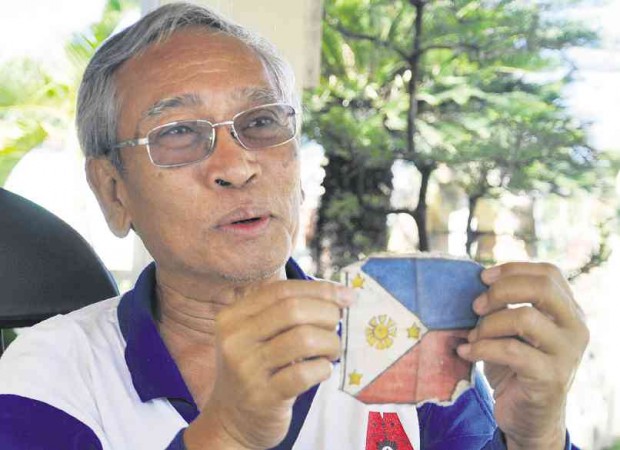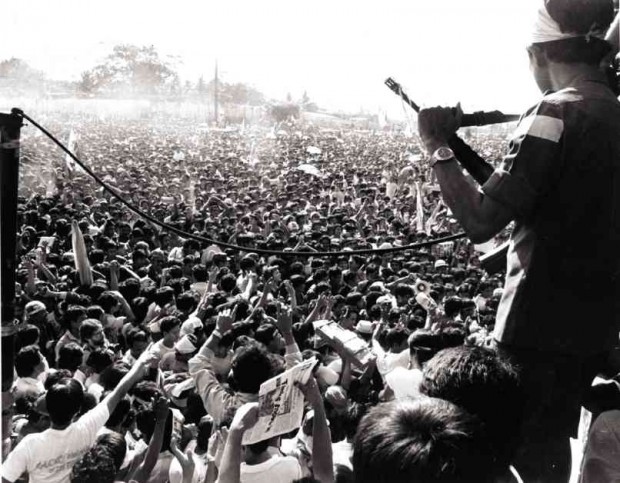‘We were ready to die’
Thirty years may have passed, but Paterno Orduña has vivid memories of his participation in the 1986 Edsa Revolution as a young lieutenant of the defunct Philippine Constabulary (PC).
Orduña, now 66, was the operations officer of the counterintelligence unit of the Constabulary Security Group (CSG) headed by then Lt. Col. Eduardo Matillano at Camp Crame.
“Our task was to neutralize, secure and operate broadcast facilities in Metro Manila,” said Orduña, who retired as senior superintendent from the Philippine National Police in 2006. He chose to join the PNP when the PC was abolished and integrated in the national police in 1990.
But the task of his group was only realized on the third day of the four-day bloodless revolt when they took over the government-run Channel 4 television station on Bohol Avenue in Quezon City from loyalist military forces.
His group was composed of the CSG, the Narcotics Command and the Highway Patrol Group, which were all led by military officers belonging to the Reform the Armed Forces Movement (RAM), the group that provided military support to the Edsa uprising from Feb. 22 to 25 in 1986.
Snap elections
“We were supposed to move after Christmas of December 1985. But [then President Ferdinand] Marcos suddenly announced the holding of a snap presidential elections [on Feb. 7, 1986], so there was a change of plans,” Orduña said.
His group directed its efforts in organizing and campaigning for an honest, orderly and peaceful elections. “We had several speaking engagements in universities in Metro Manila, explaining to students the need for credible elections,” Orduña said.
After the elections, widespread dissent began to surface because people believed that there was massive cheating in the elections that declared Marcos as winner, he said. Orduña was told that an “extrajudicial exercise” would be launched on Feb. 23, 1986, a Sunday.
“As early as Feb. 21, we declared a full red alert status for our group. I consolidated our men in the office with their combat uniforms and firearms,” Orduña said.
Urgent meeting
On Feb. 22, Orduña and Matillano were summoned to the office of then Lt. Col. Gregorio Honasan at the Ministry of National Defense (MND) for an urgent meeting. “We were informed that the supposed staging areas of rebel forces had been occupied by loyalist forces. Marines were deployed there,” Orduña said. He and Matillano would also learn that other rebel officers had been arrested on Feb. 21 and 22.
“Everything we planned seemed to have gone awry,” said Orduña. Honasan advised them to stand by and wait for developments. Orduña said they were also told to wait for a “very significant” announcement from then Defense Minister Juan Ponce Enrile and then PC chief Fidel Ramos.
“When General Ramos and Minister Enrile announced that evening that they were withdrawing their support from the Marcos administration, that was the signal. Everybody left the office to prepare the men,” Orduña said.

RETIRED Senior Supt. Paterno Orduña displays the patch which identified him as a rebel soldier during the 1986 EDSA Revolt.
WILLIE LOMIBAO
Counter sign
Before they moved, he said, they were given a patch of the Philippine flag silk-screened on a white cloth which identified them as part of the rebel forces. The flag had to be worn and rotated counterclockwise every day.
He recalled: “Our first assignment was to go to Novaliches [in Quezon City] to secure Radio Veritas because that was the only broadcast facility being used by the rebels. We moved at around 8 p.m. in a convoy of vehicles with 100 men.”
At first, residents near the area thought the rebel soldiers were there to stop the Radio Veritas broadcast, which was then airing a blow by blow account of the Ramos and Enrile withdrawal and the call for support of Manila Archbishop Jaime Cardinal Sin.
“I cannot forget [the late comedian] Bert Marcelo, whose house was near Radio Veritas, because he allowed us to use his phone to enable us to call our families and loved ones,” said Orduña.
Last communion
On Feb. 23, a Mass was held in the station and everyone took our communion, thinking it was going to be our last because there were persistent reports that loyalist forces would be sent to attack us,” Orduña said.
At noon, a Metrocom officer arrived with the military’s elite forces to enforce a closure order meant for Radio Veritas. But he said Matillano and the other officers prevailed upon the Metrocom commander to just leave.
“On the early morning of Feb. 24, we received an urgent report that loyalist forces were en route to Radio Veritas to attack us. So I ordered my men to wear civilian clothes and take our private vehicles. We went out, brought explosives, planted explosives under a bridge and ignited them,” Orduña said.
His team began to abandon Radio Veritas when it could no longer broadcast after its transmission facilities in Bulacan province were destroyed by loyalist forces the previous night.
Channel 4 takeover
It was then that his team was ordered to proceed to Channel 4 and take the station from loyalist forces. “After a brief firefight, we were allowed inside by the Air Force personnel securing the facility. We were hugging each other. Some of them were crying and we told them that we should not fight one another and that we should unite for our country,” Orduña said.
On Feb. 25, Orduña was sent to block a road where a column of loyalist military armored vehicles was to pass. When he arrived at Camp Crame from a successful mission that day, Orduña said he learned about the mass defection of loyalist forces to the rebels’ side.
That evening, Marcos and his family fled first to Clark Field in Pampanga province and then to Hawaii.
Orduña said he could not remember any moment during the Edsa Revolution that he felt he was afraid to die. “I don’t know, but there was a different feeling at that time. Our spirit was high and we were ready to die. Maybe because we were young then,” he said.















